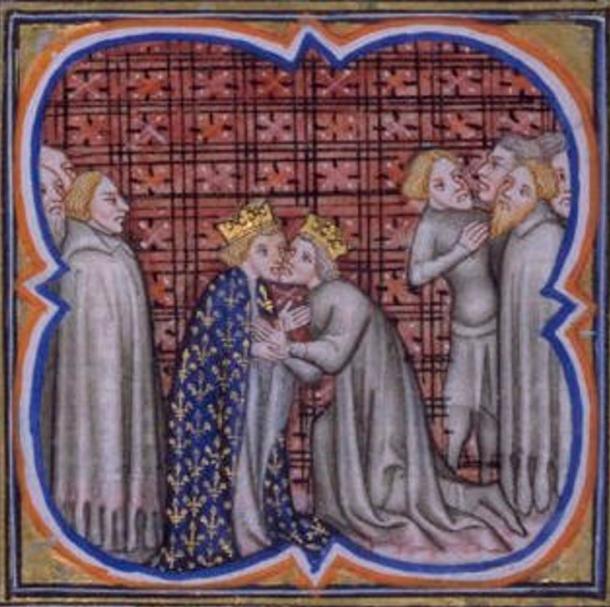
Edward I was a Strong and Formidable King Whose Presence Once Caused A Man to Die of Fright!
Edward I (known also as Edward Longshanks and the Hammer of the Scots) was an English king who lived during the 13 th and 14 th centuries AD. Edward belonged to the House of Plantagenet, whose ancestry may be traced back to the Geoffrey V, the Count of Anjou. Not only is Edward remembered for his military campaigns against the Welsh and the Scots, but also for the important legal and administrative reforms he carried out in the kingdom.

Edward I. (Willud Edier / Public Domain)
Did Edward Take After the Saint He Was Named After?
Edward I was born in 1239 in Westminster and was the eldest son of Henry III and Eleanor of Provence. Henry is recorded to have been a pious man and named his first-born son in honor of his favorite saint, Saint Edward the Confessor. As he grew up, however, Edward would bear little resemblance to the saint he was named after. As a young man, Edward was recorded to have been arrogant, violent, and cruel. According to a story, a man once died of sheer fright in his presence. Apparently, Edward’s contemporaries found this tale easy to believe. In addition to his character, Edward was also distinguished for his physique. Standing at a height of 1.88 m (6 feet 2 inches), Edward earned the epithet ‘Longshanks’.

Saint Edward the Confessor whom Edward was named after. (anonymous / Public Domain)
Succession After the Death of His Father
Edward succeeded his father as King of England after the latter’s death in 1272. Edward had been crusading in the Middle East and only received the news of his father’s death when he was in Sicily. During his journey back to England, Edward stopped in Paris to do homage to Philip III, the King of France, for his French possessions and stayed for several months in Gascony. Edward arrived in Dover, England on the 2 nd of August 1274 and his coronation ceremony took place on the 19 th of August.
- Archaeologists Say They Have Found an Important Medieval Site Linked to Scottish Hero William Wallace
- The Life and Legend of the Aldworth Giants
- Archaeologists reveal lost medieval palace beneath prehistoric fortress at Old Sarum

Edward I of England doing homage to Philip. (Anonymous / Public Domain)
Edward’s First Act as King was War
One of the first things Edward did as king was to launch a military campaign against Wales. At that time, Wales was controlled by Llywelyn Ap Gruffudd. Although Llywelyn originally ruled over northern Wales, he was able to take advantage of the Second Barons’ War to expand and consolidate his power over almost all of Wales. Henry III recognized Llywelyn’s sovereignty in exchange for tribute. During Edward’s coronation, Llywelyn was absent and refused to pay homage to the king. Edward saw this as a pretext for going to war with Llywelyn, whom he regarded to be a rebel. The Welsh were defeated, and Wales was brought into the English legal framework.
Edward Strives to Control Scotland
Edward is also known for his military campaigns against the Scots. In 1292 the king was asked to arbitrate a dispute regarding the Scottish succession crisis. John Balliol, a puppet of Edward, was ultimately appointed as the King of Scotland. Although Scotland had its own king, Edward continued to meddle in Scottish affairs. The Scottish nobles grew increasingly frustrated with Edward, eventually forcing Balliol to repudiate Edward’s claims as suzerain and to ally with France. Edward responded by invading Scotland. Although the English succeeded in conquering Scotland, Scottish resistance continued throughout the rest of Edward’s reign. It was in 1306 that Robert the Bruce was crowned as King of the Scots at Scone. Furious, Edward led his army against the Scots, but the king died in 1307 before engaging his enemy.

King John of Scotland - a puppet of Edward, his crown and scepter symbolically broken and with an empty coat of arms. (Forman Armorial / Public Domain)
Edward was Strong in Governmental Reforms
Apart from his military accomplishments, Edward was also notable for the legal and administrative reforms that he implemented. For instance, between 1275 and 1290, a series of statues to increase the authority of the Crown and the Parliament were introduced by the king. In addition to increasing its authority, it was also thanks to Edward that Parliament became a permanent institution in England. Finally, the important contribution made by Edward to English common law is evident in one of the nicknames he received, i.e. the ‘English Justinian’.

16th-century illustration of Edward I presiding over Parliament. The scene shows Alexander III of Scotland and Llywelyn ap Gruffudd of Wales on either side of Edward; an episode that never actually occurred. (churchill-society-london / Public Domain)
Top image: On Left – Early fourteenth-century manuscript showing Edward I. On Right – Early fourteenth-century manuscript showing Edward I and his wife Eleanor. Source: Left, Public Domain Right, Public Domain
By Ḏḥwty
References
Cavendish, R., 2007. Death of Edward I of England. [Online]
Available at: https://www.historytoday.com/richard-cavendish/death-edward-i-england
Dean and Chapter of Westminster, 2018. Edward I and Eleanor of Castile. [Online]
Available at: https://www.westminster-abbey.org/abbey-commemorations/royals/edward-i-and-eleanor-of-castile/
The BBC, 2014. Edward I (1239 - 1307). [Online]
Available at: http://www.bbc.co.uk/history/historic_figures/edward_i_king.shtml
Treharne, R. F., 2018. Edward I. [Online]
Available at: https://www.britannica.com/biography/Edward-I-king-of-England
www.englishmonarchs.co.uk, 2018. Edward I. [Online]
Available at: http://www.englishmonarchs.co.uk/plantagenet_5.htm
www.historynet.com, 2006. King Edward I: England’s Warrior King. [Online]
Available at: http://www.historynet.com/king-edward-i-englands-warrior-king.htm
www.royal.uk, 2018. Edward I 'Longshanks' (r. 1272-1307). [Online]
Available at: https://www.royal.uk/edward-i-longshanks















